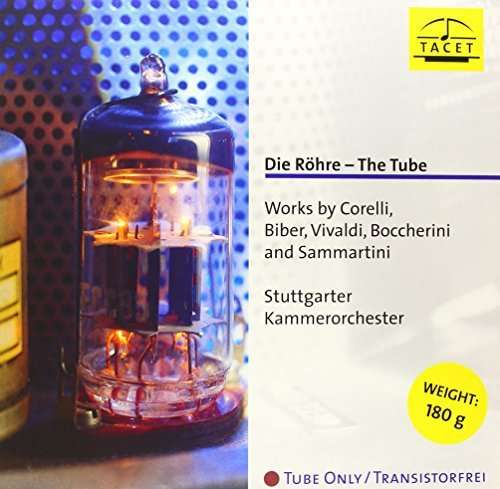Die Rohre The Tube Works by Corelli, Biber, Vivaldi, Boccherini and Sammartini
TAS Rated 4/5 Music, 4/5 Sonics in the October 2011 Issue of The Absolute Sound!
No conductor, no semiconductor--I beg your pardon?
The Stuttgart Chambert Orchestra: Leader-Bejamin Hudson, Violin 1-Benjamin Hudson, Wolfgang Kussmaul, Midori Tanaka, Adriana Ringler, Manfred Wetzler, Violin 2-Henning Trubsbach, Attila Demus, Lian MacPhasil, Onur Kerstel, Viola-Tetsuya Hayashi, Hans-Joachim Dann, Stanislas Bogucz, Emanule Wieck, Violoncello-Gyorgy Bognar, Reinhard Werner, Doublebass-Konrad Neander, Harpischord-Rien Voskuilen.
It seems that the wish to reproduce sounds in a musical way to the real world is a phenomenon which can be traced back to the historic beginnings of music. Sound imitation reached its first heyday in the Renaissance, for example in the chansons by Clemet Janequin, who let his singers perform first a birds' concert and then the battle of Marignano with their vocal chords. The musical portrayal of battles was a subject commonly chosen in the following centuries, but the singers were gradually superseded by instrumentalists who from the 17th century onwards gradually came out of the shadows of vocal music more and more. One of them, Hienrich Ignaz Franz Biber, was one of those violinists who could extend the spectrum of his instrument by re-tuning the strings and other effects in a quite astounding manner. One of the most unusual pieces by Biber is his "Battalia" composed in 1673, in which the sound of the instruments is characteristically estranged by beating with the wood of the box or drawing a strip of paper through the strings. In one section in which he portrayed life in camp, Biber seems like a forerunner of Charles Ives: the instruments unite in different ways to a cacophony, a chaos of sound, which can easily be recognised as the drunken ravings of the peasants.
Biber did not have this work printed, unlike most of his compositions. The whole thing was able to pass as a musical amusement but to the ears and eyes of outside listeners it would seem like amatuer nonsense. Similar reasons prevented the cellist Luigi Boccherini from publishing his string quintet "La Musica Notturna delle strade de Madrid" (Night music in the streets of Madrid) during his own lifetime. In a short note to the manuscript of his work which was written around 1780, Boccherini wrote: "This little quintet describes the music which can be heard on the streets of Madrid at night, beginning with the bells of the Ave Maria and ending with a parade of military guards. All this is written without strict adherence to the rules of composition, but attempts to portray reality as faithfully as possible."
The Concerto grosso enjoyed much popularity at this time. Another Italian had provided the reason for this: Arcangelo Corelli, the great violinist, whose solo and trio sonatas were famous in his lifetime all over Europe. The twelve Concerti Grossi op. 6 appeared in 1714, after Corelli's death, but then quickly became a model for numerous other composers.
Although opera was dominant, some instrumental works were of course created in Italy, so to speak in opera's shadow. The concertos by the Venetian Antonio Vivaldi were even known all over Europe, they made such a lasting impression on the concerto genre that even Johann Sebastian Bach studied the closely and followed on from them in his own composition. A remarkable number of Vivaldi's concertos bear subtitles like the famous group of four "I quattro stagioni" (The Four Seasons), subtitles which refer to a programmatic background. In the brief concerto "alla rustica" it is to a specific character that Vivaldi refers ironically, for the simple, sometimes coarse structure of the short work imitates the playing of simple musicians such as were to be found in the country.
The numerous concertos and chamber muisc works which Vivaldi left us and the great effect they have had has blinded the world to the fact that Vivaldi by rights was offically a church musician, in spite of the fact that he is said to have composed around 90 operas. Like Vivaldi, Givoanni Battista Sammartini was first and foremost a church musician. His symphonies which made him famous all over Europe were composed as if it were in his spare time.
All selections on this unique LP are recorded at every stage with tube components. Tube microphones, tube mixers, tube amplifiers and finally tube mastered. The gatefold album jacket features pictures of the many pieces of gear used to make this wonderful recording.
Selections: Concerto grosso op. 6 No. 7 D major, Battalia a 10, Conerto all Rustica G major RV 151, La Musica Notturan delle strade di Madrid, Sinfonia F major JC35.

